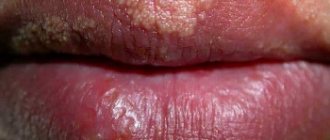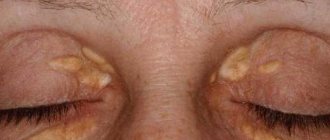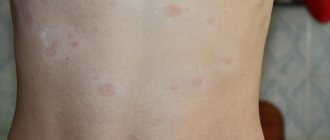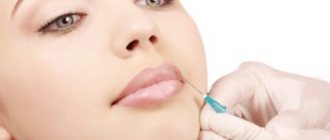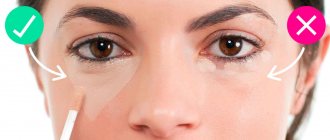In medicine, xanthelasma of the eyelids is one of the types of xanthoma (yellow growths on the skin that arise due to disorders of fat metabolism in the body). The name “xanthelasma” itself comes from the Greek words “xanthos” - golden and “elasma” - plaque, plate. In scientific circles, there is an opinion that patients suffering from this feature are predisposed to develop widespread vascular atherosclerosis or coronary heart disease.
- 5 Treatment
- 6 Treatment prognosis and possible complications, consequences
- 7 Prevention
- 8 Patient reviews about the treatment of the problem
Causes of xanthelasma
Doctors note that xanthelasmas of the eyelids are benign in nature, flat and sometimes extremely convex in shape. The surface of the plaques is wrinkled or smooth, and the color is whitish-yellow or light orange. The size of each plaque is 2-50 mm. Xanthelasmas do not cause discomfort in a person, they do not hurt, a person does not even notice them in the course of his life, since it is only a cosmetic defect. With a small plaque size, the eyelid works normally.
It is not known why xanthelasmas appear on the body - scientists cannot figure out the reasons. But studies on this topic have been repeatedly conducted, during which some details have been clarified, so, presumably, the following factors may influence the formation of plaques:
- overweight;
- diabetes mellitus (with a small amount of insulin in the body, glucose accumulates, which affects its vital functions);
- pancreatitis;
- liver diseases;
- myxedema (a disease in which the thyroid gland almost does not function and does not produce thyroid hormones);
- lipoid nephrosis;
- increased cholesterol levels in the blood.
In children, xanthelasma appears in a hereditary manner, just like xanthomatosis. The next step is that the liver stops functioning normally, and problems with the cardiovascular system appear. Further, cystic formations may appear on the hands. Xanthomatosis is the appearance of a very large number of xanthomas on the skin.
Appearance of formation (xanthelasma)
The photo of xanthelasma of the eyelids shows that it can be of small size. It resembles a plaque that forms in the upper eyelid area. Most often, the formation is located closer to the inner corner of the patient's eye.
The plaque protrudes slightly above the surface of the skin, making it visible to the naked eye.
The tumor differs in color from the surrounding skin - it has a yellowish tint. The formation has a soft consistency; when pressed, the patient does not feel pain.
Xanthelasmas can be single or multiple. The tumors usually affect the eyelids of both eyes.
Multiple xanthelasmas can merge into single plaques that have fuzzy edges and a bumpy surface. Often the neoplasms form a continuous thin line that runs along the entire surface of the eyelid.
The formations appear suddenly, without any redness or other changes in the skin of the eyelids. They grow very slowly and gradually spread over the entire surface of the eyelid.
Xanthelasmas usually grow to the size of a small pea; in rare cases, they grow to the size of a bean (approximately 4-5 cm). Tumors do not cause any unpleasant sensations to the patient, with the exception of psychological discomfort from their appearance.
However, tumors significantly affect the patient’s appearance and prevent them from feeling healthy, so they are considered a rather large cosmetic problem.
In addition to tumors on the eyelids, patients often develop tumors on other parts of the body - face, neck, limbs, joint surfaces.
Such formations are called xanthomas. Their appearance indicates that the patient has a specific disease - xanthomatosis.
What is the difference between xanthelasmas and xanthomas
For the common man there is no difference between these formations. And the cells themselves are very similar. The difference lies in the origin of both forms. In the case of xanthelasma, the appearance of plaques is practically not due to the presence of excess triglycerides in the blood. This cannot be said about xanthomas, the cause of which is problems with lipid metabolism.
People who suffer from xanthelasma do not (usually) have excess lipids in their blood. After their appearance, cholesterol increases slightly in quantity. And although this is an established fact, many classify xanthelasmas as flat xanthomas.
But this is not the only difference between the formations. They are also different in their locations. Thus, xanthelasmas form near the eyelids and are a purely cosmetic problem. But xanthoma can have different locations and forms of manifestation. So, there may be tuberous xanthomas that affect the skin of the elbows and knees. And the tendon forms grow in the area of the extensor tendons of the limbs and in the area of the Achilles tendon. There are also eruptive xanthomas (when plaques gather in whole clusters and can be located anywhere in the body), flat ones, etc.
At-risk groups
Most often, xanthelasmas affect older people. The most common group of patients are women over 45 years of age who suffer from diabetes mellitus, have excess cholesterol in the blood and other lipid metabolism disorders. But this does not mean that men cannot suffer from yellow plaques.
The disease appears unexpectedly and has no warning signs. This means that at any moment a person can become its “victim”. Don’t think that xanthelasma will go away on its own. If a plaque appears, it will only grow, and disappearance is not typical for such neoplasms.
Expert opinion
- Cosmetologist
- Surgeon
Anna Avaliani
practicing cosmetologist
I think that it is better not to self-medicate using traditional methods, but to go to the doctor. To be sure to get rid of the plaque, it is better to resort to radical excision by any method (laser, liquid nitrogen, etc.). These are minimally invasive techniques, as they do not require the use of general anesthesia.
Aisha Baron
plastic surgeon
You can get confused in the variety of xanthelasma removal methods.
But the most effective way can be considered coagulation using a laser. The procedure has many advantages. After it, rehabilitation does not last long, the plaque will not appear again, the session itself is painless, and the risk of complications is reduced to zero. The procedure will take about 15-30 minutes. Xanthelasmas are neoplasms that are an important prognostic sign. Their occurrence indicates that the patient’s body has a disturbance in the metabolism of fat molecules.
Therefore, you should not delay treatment of the disease. You need to consult a specialist and undergo an examination to discover the cause of the formation of tumors.
The likelihood of degeneration of xanthelasma
There are no documented factors for doctors to record how xanthelasma degenerated into any malignant neoplasm. Therefore, many live with her and do not worry about their future fate. And if xanthelasma is removed, then only for decorative purposes, to improve the appearance of the face.
The excised plaques were repeatedly subjected to research, during which their composition was determined. There is a lot of cholesterol and phospholipids, which are also in an elevated state in the blood of xanthelasma carriers.
Removing xanthelasma with laser
Today this is the most effective way to get rid of xanthelasma quickly and permanently. The effect occurs using a carbon dioxide laser, which has been successfully used in aesthetic cosmetology for almost three decades. It destroys fatty structures without damaging surrounding tissues. The operation is more expensive than other methods, but has many advantages:
- no mechanical trauma to the skin;
- rapid bleeding stop;
- complete sterility;
- high accuracy of tumor removal;
- absence of scars;
- short rehabilitation period.
Laser treatment is widely used to treat various skin problems. Removal of xanthelasma using a carbon dioxide laser gives good results. The tumor disappears and there are no more relapses.
After surgery, you need to adhere to a special diet for 1-2 weeks, eliminating fats from the diet and minimizing the consumption of carbohydrate foods. In the future, to prevent the disease, you should eat right.
Treatment of xanthelasma of the eyelids
Today there are no specific drugs that are guaranteed to cure xanthelasma. But there are a number of methods that allow you to hide the defect or remove it. The decision on taking specific measures is made by the doctor together with the patient during the examination. So, today this cosmetic problem can be removed using one of the following options:
- surgical intervention;
- cryodestruction (xanthelasma is burned off with nitrogen);
- laser removal;
- electrocoagulation;
- radio wave destruction.
As noted, yellow plaques in the eye area are not just a cosmetic defect, but sometimes a lipid pathology. This means that it needs to be treated and eliminated. A specialized doctor can prescribe insulin injections, prescribe thyroid tablets and other treatment.
You will like: Treatment of hyperhidrosis
A blood test is also done, its composition is determined and a conclusion is made about the cholesterol level. If it is high, a diet is prescribed that prevents animal fats from entering the body. They also prescribe medications that fight cholesterol already in the body. These are choline chloride, nicotinic acid, ascorbic acid, pyridoxine, etc.
It must be remembered that many drugs for removing cholesterol have a choleretic effect, which means that they are contraindicated for diseases of the gallbladder.
Causes of xanthelasma plaques
The main reason is an imbalance in lipid metabolism - hyperlipidemia, or histiocytosis, which causes cholesterol deposition on the vascular walls, organs and skin.
With histiocytosis, macrophages multiply and devour cells of the immune system, which leads to various biochemical disorders, for example, an abnormal increase in fat deposits.
With hyperlipidemia, cholesterol levels become abnormally high. Cholesterol exhibits two active forms that perform different functions:
- Low-density lipoproteins (LDL) are useful in removing toxins and heavy metals from the body. Triglycerides, which are part of LDL, which form atherosclerotic plaques, are recognized as dangerous substances.
- High-density lipoproteins (HDL) dissolve cholesterol plaques.
With xanthelasma, there is an accumulation of triglycerides, which, when accumulated, form tumors.
What diseases cause xanthelasma? If the disease is caused by genetic pathologies associated with abnormal lipoprotein structures, the disease can develop not only in adults, but in rare cases even in children.
Xanthelasma tumor
Xanthelasma manifests itself against the background of concomitant diseases:
- Obesity;
- Atherosclerosis:
- Coronary heart disease or peripheral vascular disease;
- Diabetes;
- Lack or excess of thyroid hormones;
- Alcohol consumption;
- Liver and kidney failure - 80% of cholesterol is produced by the liver and only 20% comes from food;
- Malignant neoplasms.
With a secondary cause, the prognosis for full recovery is more favorable with the obligatory fulfillment of certain conditions.
Removal of xanthelasma of the eyelids by a surgeon
This is the most painful approach, so local anesthetics are administered to alleviate it. Surgical treatment is practiced in case of removal of very large plaques (more than 10 mm). It happens that they practice removing small formations when necessary, but it is impossible to burn out the plaque with a laser or electric current.
Before starting the procedure, the area of skin near the plaque and it itself is impregnated with an antiseptic. When this is done, take scissors and tweezers and separate the xanthelasma. Then, with tweezers, grab the edges of the skin near the wound and treat it with iron sesquichloride. This leads to the formation of its albuminate salts, which look like a dense crust on the wound. In total, the skin heals after the intervention for about one week.
It happens that the edges of the wound after cutting become very wide that they have to be burned out with an electric current.
When the operation is over, the wound surface is treated with brilliant green or potassium permanganate. And if the plaques were very large, stitches are applied. The surgical method is the least convenient and successful, since after it bleeding from the wound is possible in the first few days, and when everything heals, unsightly scars may appear.
Treatment of xanthelasma with folk remedies
Traditional healers also have effective ways to combat xanthelasma. For these purposes, various medicinal herbs and components that promote the resorption of tumors are used.
Honey cake
To prepare such a miraculous remedy you need:
- flour - one tablespoon;
- liquid honey - one teaspoon;
- egg white - one piece.
All ingredients are mixed together. Small cakes are made from the resulting mixture, which are applied to the affected area and held for about ten to fifteen minutes. With regular use of this remedy, the tumor resolves within two to three weeks after the start of treatment.
Medicinal fee
To prepare you will need:
- rose hips – 100 grams;
- mint – 100 grams;
- immortelle – 75 grams.
Pour three tablespoons of the resulting mixture into 600 grams of water and cook for three minutes over low heat. Afterwards, leave the resulting decoction for four hours, filter and drink 150 ml half an hour before meals. Therapy is carried out for a month, then it is stopped for two months. Then repeat again if necessary.
Electrocoagulation
They prepare for plaque removal in a similar way as for surgery. To do this, a local anesthetic is injected, and the plaque is treated with an antiseptic.
But the xanthelasma itself is removed using an electrocoagulator, at the end of which there is a thin tip. This simple electrode allows you to quickly remove the upper part of the plaque. Then, when this is done, the device removes further layers of the formation until the base is burned out. In the area of xanthelasma there are various vessels that feed it. To prevent them from bleeding, the coagulator also sets fire to their opened lumen and, as it were, seals them. That's why electrocoagulation is good - it allows you to perform surgery without causing bleeding. The patient is left with only a small crust at the site of the plaque, which needs to be watched for some time. The doctor talks about the rules for caring for the scab, since it cannot be torn off. When it comes off on its own, a small, healed, pale pink surface is revealed. It will take several months for it to go away and normal skin to appear in its place.
Complications of xanthelasma removal
Removal of eyelid xanthelasma: before and after
Problems appear quite infrequently. If yes, then these are the following phenomena:
- Repeated xanthelasmas. The disease occurs when cholesterol levels are high, and if lipid metabolism problems are not eliminated, a relapse of the tumor may occur. To prevent this from happening, you need to adjust your diet and lead a correct lifestyle.
- Wound bleeding is a common complication after surgical removal.
- The presence of a large scar - also appears after surgical treatment at the suture sites.
Patient reviews
The cost of eyelid xanthelasma removal can vary significantly, so it is recommended to read patient reviews before scheduling the procedure.
LARISSA, MOSCOW:
“I had a small plaque in the upper eyelid area, so I decided to remove it with a laser. The procedure was done very quickly, it didn’t hurt me, of course, there were some unpleasant sensations. Everything healed quickly, there were no traces left.”
ALEXEY, ST. PETERSBURG:
“I took my mother for treatment - some kind of yellow tumor appeared on her eyelid.
They said that it was already too big and could only be removed surgically. The operation was done quickly, under local anesthesia. We are pleased with the result, although there is a small scar left on the upper eyelid.”
Prevention of xanthelasma
Although scientists do not fully know how exactly xanthelasmas appear, it is reliably known in what ways their occurrence can be prevented.
First of all, it is recommended to adjust your own diet and make it more plant-protein, eating very few animal products and not taking animal fats and high-energy foods. It is recommended to check whether this food can be eaten by patients suffering from pancreatic and liver diseases. If possible, they will not cause xanthelasma.
The doctor may order a full examination of the body and decide to prescribe medications that interfere with lipid metabolism. But you shouldn’t prescribe them yourself, as you can even worsen the problem.
You should also not diagnose yourself with xanthelasma. Skin plaques can be dangerous, and only a doctor can assess the extent of the pathology. For example, instead of harmless xanthelasma, pseudoxanthoma, syringoma, melanoma and other tumor neoplasms may appear on the skin.
Diagnostics
If a tumor occurs in the eyelid area, the patient is advised to make an appointment with a dermatologist. A specialist determines the presence of xanthelasma based on its appearance - a flat yellowish formation in a characteristic location.
Additionally, during the examination, the dermatologist uses the diascopy technique. The formation is compressed with a transparent glass slide. This can achieve bleeding of xanthelasma. Due to the outflow of blood, the yellow color of the tumor is more clearly visible.
It is necessary to differentiate xanthelasma with the following diseases:
- malignant neoplasms of the skin;
- elastic pseudoxanthoma;
- syringoma.
Based on the clinical manifestations of the disease, the specialist diagnoses the patient and sends him for a full examination.
After determining xanthelasma, the patient must undergo a blood lipid test. For this purpose, the level of cholesterol, triglycerides and lipoproteins is determined.
Diagnostics allows you to assess the level of risk for the development of such dangerous diseases as atherosclerosis, hypertension and myocardial infarction.
What to do to avoid relapse
The disease can easily recur, so a patient who has undergone xanthelasma removal should know about methods that will protect him from this:
- Switching to a dairy-vegetable diet. This means eliminating fatty meats and other high-calorie foods. Animal oils are allowed in the amount of 25 g per day, and vegetable oils - 75 g.
- Do not injure the skin. If there are frequent skin injuries in the area of former xanthelasmas, multiple relapses may occur, which will be more difficult to eliminate.
Question answer
An important quality of xanthelasma is that the neoplasm never degenerates into cancer.
Therefore, the risk to the patient’s health is practically minimal. Very rarely, patients experience bleeding at the extraction site, and an unsightly scar may also form. In addition, such a plaque can form again. For everything to go well, you need to go to a good specialist.
There are certain rules of prevention. To do this, doctors recommend adhering to proper nutrition, reducing the consumption of carbohydrates and animal fats. It is worth treating diseases that provoke tumor formation in a timely manner, not injuring the eyelids, removing makeup, using good cosmetics, and regularly seeing a dermatologist.
